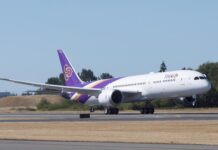 Viasat Inc. announced that business aviation customers using its in-flight connectivity solution on super-midsized private jets are now benefitting from expanded coverage into the Middle East and South America.
Viasat Inc. announced that business aviation customers using its in-flight connectivity solution on super-midsized private jets are now benefitting from expanded coverage into the Middle East and South America.
The service enhancement is available to current and future customers using Viasat’s Global Aero Terminal (GAT) 5510, which already provides high-performance connectivity with uncapped speeds over North and Central America, the Caribbean, North Atlantic flight tracks and Europe. Expanded coverage into the Middle East and South America has been delivered by optimising the use of Viasat’s satellite network assets and management tools, with existing customers only requiring a simple over-the-air software download and remote configuration.
The compact GAT 5510 terminal is certified on a range of different private jets. Available as a line-fit option on the Gulfstream G280, Bombardier C3500 and Embraer Praetors, it is also a retrofit option through Viasat’s network of authorized dealers, with Supplemental Type Certificate (STCs) on several popular airframes.
Kai Tang, Head of Business Aviation at Viasat, said: “Viasat has a successful track record of delivering high-performance connectivity to a large number of super-midsized private jets, allowing passengers to seamlessly access the most data-hungry applications, such as high-definition video conferencing, content streaming and bulk file transfers. This is a very important segment of our market and has shown significant growth, driven by large fleet operators who have emphasized the importance of coverage into the Middle East and South America. We’ve received extremely positive feedback since responding to that need and look forward to building on this momentum with will announce other strategic coverage extensions soon. This also marks an important step in harmonising Viasat business aviation solutions following our acquisition of Inmarsat. As our service for super-midsized private jets continues to evolve, it has also transitioned from its former name of Viasat Ka and is now part of our next generation JetXP in-flight connectivity brand. As a result, the total number of JetXP customers now exceeds 600 worldwide, signalling a strong and rapid uptake in the market.”
JetXP became commercially available at the end of last year, with the launch of new service plans for Viasat’s legacy Jet ConneX solution. Hundreds of customers have already upgraded to the JetXP service plans, enjoying a range of premium benefits, such as uncapped speeds, expanded capacity and increased network prioritization. Today’s announcement marks another milestone, as customers of the legacy Viasat Ka business aviation service have now also transitioned to JetXP, following the introduction of expanded capacity.
This supports Viasat’s continued focus on taking business aviation in-flight connectivity to the next level by unleashing the full power of its global Ka-band network and building on a successful track record for delivering consistent, reliable and seamless global connectivity, complemented by the white-glove customer service and 24/7 support of its distribution partners – Collins Aerospace, Gogo and Honeywell.
The service was developed following extensive consultation with customers, partners and research agencies, in addition to detailed analysis of usage trends over recent years. The results indicated that expectations around business aviation connectivity have evolved considerably. Traditional speed-based plans are now outdated, especially those that advertise a top-speed without details around when, where and how frequently it will be achieved. Instead, the business aviation industry has broadened its focus to the overall experience.
“This sentiment has also been reflected by insights from our annual industry survey, which asked business aviation professionals to share their views on in-flight connectivity. Reliability, coverage, consistency and overall experience – including white-glove customer service and 24/7 global support – were found to be the most important factors, followed by speed. So while we’re consistently seeing speeds that exceed 100Mbps over Europe and other regions, these survey results highlight the market’s understanding that beyond a certain bandwidth threshold, high speed tests do not reflect the actual passenger experience. Instead, you need a combination of several different factors and that’s where JetXP really excels,” added Tang.



















